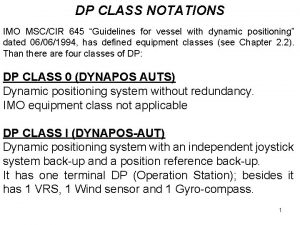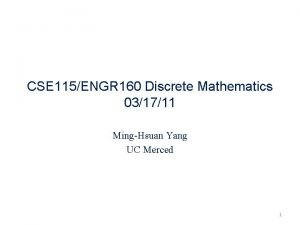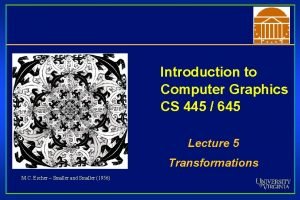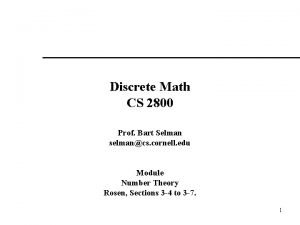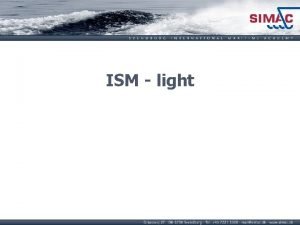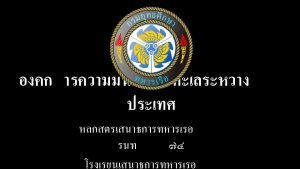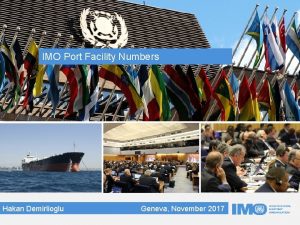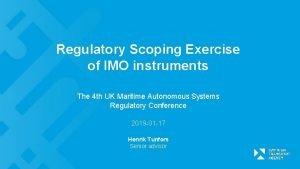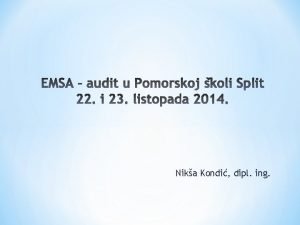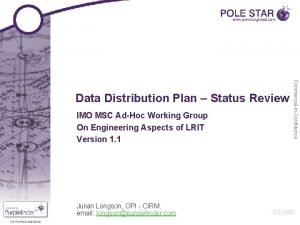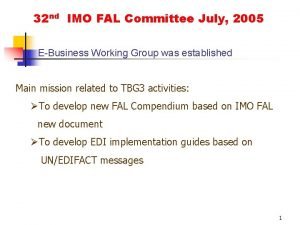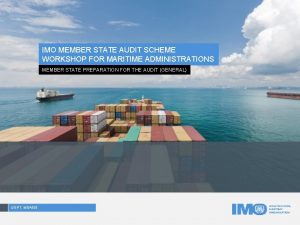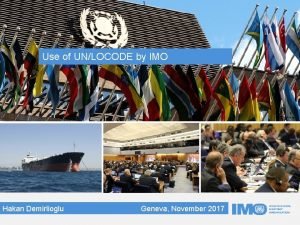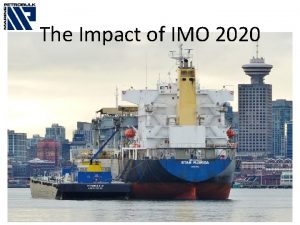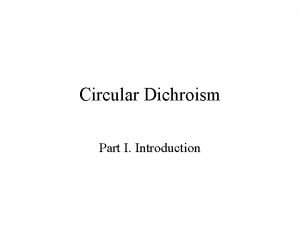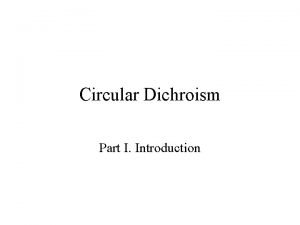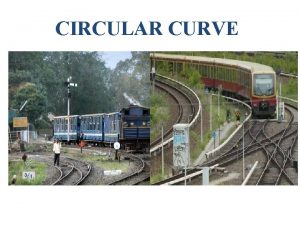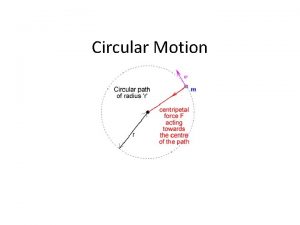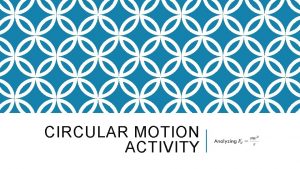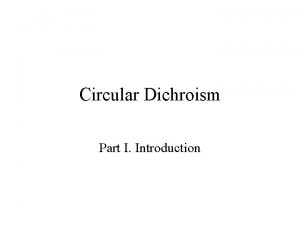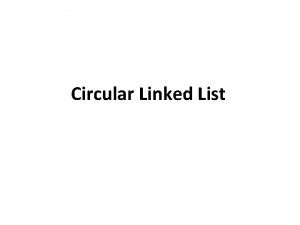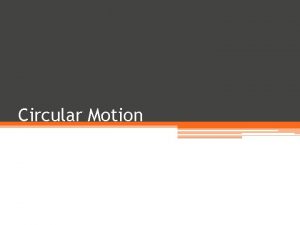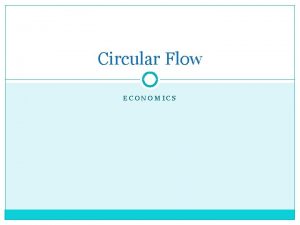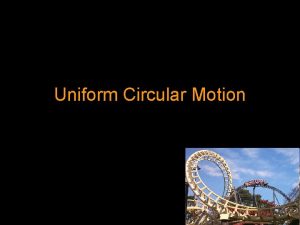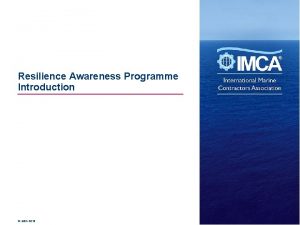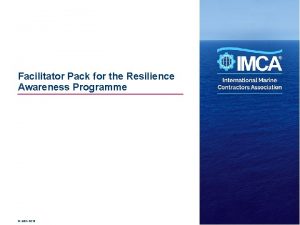Revision of IMO Circular 645 and IMCA M


























- Slides: 26

Revision of IMO Circular 645 and IMCA M 117 Andy Goldsmith, Technical Adviser - Marine European DP Conference 2017 7 February 2017 © IMCA 2017

GUIDELINES FOR VESSELS AND UNITS WITH DYNAMIC POSITIONING SYSTEMS WHAT IS THE PURPOSE OF THIS DOCUMENT? © IMCA 2017 2

REVISION OF IMO CIRCULAR 645 SECTION 1 DEFINITIONS • The number of definitions has increased from nine to twenty six • Example additions to existing definitions − DP Control system includes networks − Position keeping means maintaining position and/or heading or track − Power system now includes UPS and power management system • Example new definitions used during testing and operations − Activity Specific Operating Guidelines (ASOG) − Consequence analysis − Failure Modes and Effects Analysis (FMEA) − Hidden failure − Time to safely terminate − Worst-Case Failure (WCF) − Worst-Case Failure Design Intent (WCFDI) © IMCA 2017 3

REVISION OF IMO CIRCULAR 645 SECTION 2 EQUIPMENT CLASSES • A DP Class Zero will not be introduced • The term reliability to be removed from the document, reference will be to redundancy only • Any reference to loss of position within the document also now includes and/or heading − 2. 7 It is a provision of the guidelines that the DP vessel is operated in such a way that the worstcase failure, as determined in 2. 2, can occur at any time without causing a breach of acceptable excursion criteria set for loss of position and/or heading for equipment classes 2 and 3. © IMCA 2017 4

REVISION OF IMO CIRCULAR 645 SECTION 3 FUNCTIONAL REQUIREMENTS GENERAL • Mission related external forces to be considered − 3. 1. 2 If external forces from mission-related systems (cable lay, pipe lay, mooring, etc. ) have a direct impact on DP performance, the influence of these systems should be considered and factored into the DP system design. Where available from the DP system or equipment manufacturer, such data inputs should be provided automatically to the DP control system. Additionally, provisions should be made to provide such data inputs into the DP control system manually. These systems and the associated automatic inputs should be subject to surveys, testing and analysis specified in 5. 1. • Activation of redundant components − 3. 1. 6 Redundant components and systems should be immediately available without needing manual intervention from the operators • Hidden failure monitoring − 3. 1. 7 For equipment classes 2 and 3, hidden failure monitoring should be provided on all devices where the FMEA shows that a hidden failure will result in a loss of redundancy. © IMCA 2017 5

REVISION OF IMO CIRCULAR 645 SECTION 3 FUNCTIONAL REQUIREMENTS GENERAL • Equipment requirements and positioning of the DP control station − 3. 1. 8 The DP control station should be arranged where the operator has a good view of the vessel's exterior limits and the surrounding area. Equipment that should be located at the DP control station includes, but is not limited to: 1 DP control and independent joystick control operator stations; 2 manual thruster levers; 3 mode change systems; 4 thruster emergency stops; 5 internal communications; and 6 position reference systems’ Human Machine Interface when considered necessary. © IMCA 2017 6

REVISION OF IMO CIRCULAR 645 SECTION 3 FUNCTIONAL REQUIREMENTS POWER SYSTEM • Requirement for an automatic power management system (PMS) − 3. 2. 6 For equipment classes 2 and 3, if a power management system is installed at least one automatic power management system (PMS) should be provided and should have redundancy and reliability according to the equipment class and a blackout prevention function. • Acknowledgement that alternative methods of energy storage are in use − 3. 2. 7 Alternative energy storage (e. g. batteries and fly-wheels) may be used as sources of power to thrusters as long as all relevant redundancy, independency and separation requirements for the relevant notation are complied with. For equipment classes 2 and 3, the available energy from such sources may be included in the consequence analysis function required in 3. 4. 2. 4 when reliable energy measurements can be provided for the calculations. © IMCA 2017 7

REVISION OF IMO CIRCULAR 645 SECTION 3 FUNCTIONAL REQUIREMENTS THRUSTER SYSTEM • Individual thruster control − 3. 3. 1 Each thruster on a DP system should be capable of being remote-controlled individually, independently of the DP control system. • Thruster emergency stops − 3. 3. 6 Individual thruster emergency stop systems should be arranged in the DP control station. For equipment classes 2 and 3, the thruster emergency stop system should have loop monitoring. For equipment class 3, the effects of fire and flooding should be considered. © IMCA 2017 8

REVISION OF IMO CIRCULAR 645 SECTION 3 FUNCTIONAL REQUIREMENTS DP CONTROL SYSTEM • Uninterruptable power supply for the whole system not just DP computers − 3. 4. 1. 8 A dedicated uninterruptable power supply (UPS) should be provided for each DP computer system DP control system (i. e. minimum one UPS for equipment class 1, two UPSs for equipment class 2 and three UPSs for equipment class 3) to ensure that any power failure will not affect more than one computer system and its associated components. The reference systems and sensors should be distributed on the UPSs in the same manner as the control systems they serve, so that any power failure will not cause loss of position keeping ability. An alarm should be initiated in case of loss of charge power. UPS battery capacity should provide a minimum of 30 minutes operation following a main supply failure. For equipment classes 2 and 3, the charge power for the UPSs supplying the main control system should originate from different power systems © IMCA 2017 9

REVISION OF IMO CIRCULAR 645 SECTION 3 FUNCTIONAL REQUIREMENTS COMPUTERS • Automatic transfer of control − 3. 4. 2. 5 Redundant computer systems should be arranged with automatic transfer of control after a detected failure in one of the computer systems. The automatic transfer of control from one computer system to another should be smooth within the acceptable limitations of the operation with no loss of position and/or heading. • New Section emphasising the required isolation and integrity of DP systems: − 3. 4. 2. 7 Each DP computer system should be isolated from other on-board computer systems and communications systems to ensure the integrity of the DP system and command interfaces. This isolation may be effected via hardware and/or software systems and physical separation of cabling and communication lines. Robustness of the isolation should be verified by analysis and proven by testing. Specific safeguards should be implemented to ensure the integrity of the DP computer system and prevent the connection of unauthorized or unapproved devices or systems. © IMCA 2017 10

REVISION OF IMO CIRCULAR 645 SECTION 3 FUNCTIONAL REQUIREMENTS PRS AND SENSORS • New requirement for equipment Class 1 vessels − 3. 4. 2 For equipment class 1, at least two independent position reference systems should be installed and simultaneously available to the DP control system during operation. • Further emphasis of the isolation required for equipment class 3 vessels − 3. 4. 4 For equipment class 3, one of each type of sensor should be connected directly to the backup DP control system, and should be separated by an A-60 class division from the other sensors. If the data from these sensors is passed to the main DP control system for their use, this system should be arranged so that a failure in the main DP control system cannot affect the integrity of the signals to the backup DP control system. © IMCA 2017 11

REVISION OF IMO CIRCULAR 645 SECTION 3 FUNCTIONAL REQUIREMENTS IJS • New section specifying the independent joystick as a separate system − 3. 7. 1 A joystick system independent of the automatic DP control system should be arranged. The power supply for the independent joystick system (IJS) is to be independent of the DP control system UPSs. An alarm should be initiated upon failure of the IJS. − 3. 7. 2 The IJS should have automatic heading control. © IMCA 2017 12

REVISION OF IMO CIRCULAR 645 SECTION 4 OPERATIONAL REQUIREMENTS • Use of decision support tools – ASOG’s − 4. 1 Before every DP operation, the DP system should be checked according to applicable vessel specific location checklist(s) and other decision support tools such as Activity-Specific Operating Guidelines (ASOG) to make sure that the DP system is functioning correctly and that the system has been set up for the appropriate mode of operation • Provision of DP capability plots − 4. 5 DP capability polar plots should be produced to demonstrate position keeping capacity for fully operational and post worst-case single failure conditions. The capability plots should represent the environmental conditions in the area of operation and the mission-specific operational condition of the vessel. © IMCA 2017 13

REVISION OF IMO CIRCULAR 645 SECTION 4 OPERATIONAL REQUIREMENTS • New emphasis for DP operations manual requirements − 4. 6 The following checklists, test procedures, trials and instructions should be incorporated into the vessel-specific DP Operations Manuals: 1 location checklist 2 watchkeeping checklist 3 DP operating instructions 4 annual tests and procedures 5 initial and periodical (5 -year) tests and procedures 6 examples of tests and procedures after modifications and non-conformities 7 blackout recovery procedure 8 list of Critical Components 9 examples of operating modes 10 decision support tools such as ASOGs 11 capability plots © IMCA 2017 14

REVISION OF IMO CIRCULAR 645 SECTION 5 SURVEYS, TESTING AND THE DPVAD • The requirement for conducting an FMEA is included − 5. 1. 2 For equipment classes 2 and 3, a Failure Modes and Effects Analysis (FMEA) should be carried out. This is a systematic analysis of the systems to the level of detail required to demonstrate that no single failure will cause a loss of position or heading and should verify worst -case failure design intent. This analysis should then be confirmed by FMEA proving trials. The FMEA and FMEA proving trials result should be kept on board and the FMEA kept updated so that it remains current. • Summary of survey and testing requirements − Initial Survey including FMEA proving trials for class 2 and 3 vessels to include a complete test of all systems and components − Periodical test at intervals not exceeding 5 years as required above (NB this refers to the complete test not the FMEA proving trials) − Annual survey to ensure the DP system is maintained and in good working order, annual tests of all important systems and components to document the ability to keep position after single failures and validate the FMEA and operations manual. © IMCA 2017 15

REVISION OF IMO CIRCULAR 645 SECTION 5 SURVEYS, TESTING AND THE DPVAD • Flag Administrations are encouraged to issue a Dynamic Positioning Verification Acceptance Document (DPVAD) − 5. 2. 1 Compliance with these guidelines should be verified by a DPVAD issued by or on behalf of the Administration. − 5. 2. 2 A DPVAD should be issued, after survey and testing in accordance with these guidelines, by the Administration or an organization recognized by it. − 5. 2. 4 The DPVAD is issued for a period not exceeding five years, or for a period specified by the Administration. − 5. 2. 8 Results of the DPVAD tests should be readily available on board for reference. © IMCA 2017 16

REVISION OF IMO CIRCULAR 645 SECTION 6 TRAINING • A new section referring the reader to IMO requirements for training and experience of DP personnel − Personnel engaged in operating a DP system should have received relevant training and practical experience in accordance with the provisions of the STCW Code and MSC/Circ. 738 - Guidelines for Dynamic Positioning System (DP) Operator Training. © IMCA 2017 17

THE TRAINING AND EXPERIENCE OF KEY DP PERSONNEL – (IMCA M 117) WHAT IS THE PURPOSE OF THIS DOCUMENT? © IMCA 2017 18

THE TRAINING AND EXPERIENCE OF KEY DP PERSONNEL – (IMCA M 117) SECTION 4 AIM • The aim of these guidelines is to improve the safety and efficiency of DP operations, by defining minimum industry guidelines for: − training, qualification and competence levels of key DP personnel; − developing and sustaining competence through continuous professional development (CPD) for key DP personnel. • Recognised by IMO, MSC/Circ. 738/Rev. 1 will be updated to Rev. 2 to reflect the changes • Sub Committee on Human Element, Training and Watchkeeping will consider placing a footnote referencing MSC/Circ. 738/Rev. 2 within section B-V/f of the STCW Code © IMCA 2017 19

THE TRAINING AND EXPERIENCE OF KEY DP PERSONNEL – (IMCA M 117) • Feedback button added − We encourage industry feedback • Revision record added © IMCA 2017 20

THE TRAINING AND EXPERIENCE OF KEY DP PERSONNEL – (IMCA M 117) SECTION 5 KEY DP PERSONNEL IDENTIFIED • Senior DP Operator (SDPO) − lead DP watchkeeper with responsibility for the navigational safety and the DP control • DP Electrical and Electronics Technicians − Personnel fulfilling the role of electrical and electronics technicians so could be C/E, superintendent etc. • Company DP Authority − nominated person(s) with responsibility to develop and implement the training and development of all key DP personnel. © IMCA 2017 21

THE TRAINING AND EXPERIENCE OF KEY DP PERSONNEL – (IMCA M 117) SECTION 6 DP TRAINING • 6. 1 Types of Training • 6. 2 Training Records • 6. 3 Training Courses & Certification for DPO Personnel − recognises there are now more than one DPO certification process available • 6. 4 Training Courses for Key Technical DP Personnel − good technical knowledge − understand the industrial mission of the vessel • 6. 5 Training Courses for Other Personnel Involved in DP Operations − encourages others to understand DP operations © IMCA 2017 22

THE TRAINING AND EXPERIENCE OF KEY DP PERSONNEL – (IMCA M 117) SECTION 7 QUALIFICATION & KNOWLEDGE REQUIREMENTS • 7. 1 Master/OIM • 7. 2 Senior DPO (SDPO) (The person fulfilling the role) • 7. 3 DPO (The person fulfilling the role) − Certificated DPO − Junior DPO • 7. 4 Chief Engineer • 7. 5 Senior Engine Room Watchkeeper (The person fulfilling the role) • 7. 6 Engine Room Watchkeeper • 7. 7 Electrical & Electronics Technician (The person fulfilling the role) − Electronics Technician − Electrical Technician • 7. 8 Company DP Authority © IMCA 2017 23

THE TRAINING AND EXPERIENCE OF KEY DP PERSONNEL – (IMCA M 117) SECTION 9 VESSEL & INDUSTRIAL MISSION FAMILIARISATION • 9. 1 Procedure − 9. 1. 1 All Personnel − 9. 1. 2 DP Operators − 9. 1. 3 DP Technical Personnel • 9. 2 Current Project Familiarisation © IMCA 2017 24

THE TRAINING AND EXPERIENCE OF KEY DP PERSONNEL – (IMCA M 117) SECTION 10 CONTINUOUS PROFESSIONAL DEVELOPMENT (CPD) • 10. 1 CPD Definition • 10. 2 DP Competency and CPD − Continuous regular performance of DP operations − Regular training and practice of DP skills − Refresher training − Mentoring − Regular performance assessments and setting of objectives − Preparation of future technology and operational innovations • 10. 3 DP Refresher Training • 10. 4 Maintaining Personal Performance © IMCA 2017 25

www. imca-int. com Improving performance in the marine contracting industry © IMCA 2017 26
 Consequence analysis dp
Consequence analysis dp Dpvad
Dpvad Active revision vs passive revision
Active revision vs passive revision Approximate 645 to the nearest hundred
Approximate 645 to the nearest hundred 645 rounded to the nearest ten
645 rounded to the nearest ten Use algorithm 5 to find 11^644 mod 645
Use algorithm 5 to find 11^644 mod 645 645 transformations
645 transformations 3^644 mod 645
3^644 mod 645 Tt-p-645
Tt-p-645 Design elements hair
Design elements hair What is ism
What is ism Imo
Imo Gisis locode
Gisis locode How to use imo
How to use imo Hvad er imo
Hvad er imo Imo momoh
Imo momoh Imo mass
Imo mass Imo
Imo Opi-imo
Opi-imo Imo fal form 5
Imo fal form 5 Imo's
Imo's Imo's
Imo's Imo member state audit scheme
Imo member state audit scheme Imo gisis
Imo gisis Wjec hospitality and catering
Wjec hospitality and catering Crime and deviance sociology revision
Crime and deviance sociology revision Romeo and juliet revision notes
Romeo and juliet revision notes
